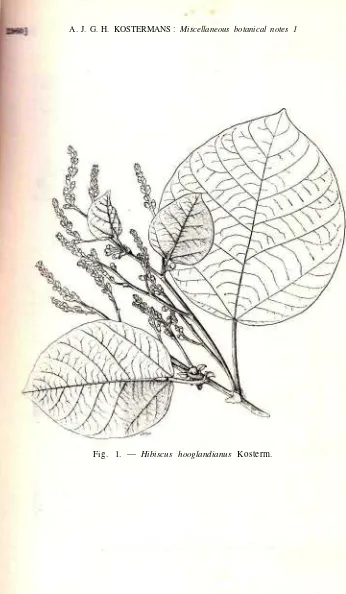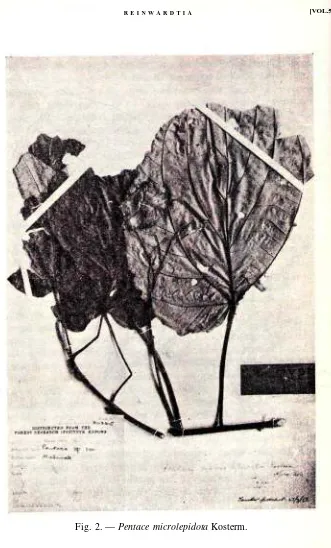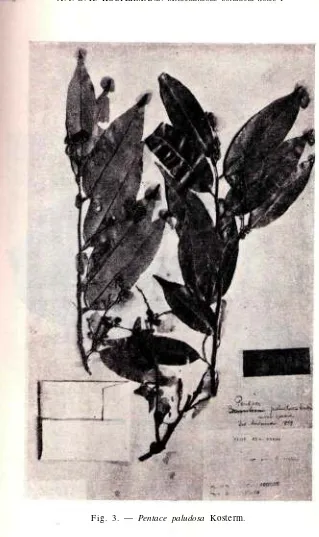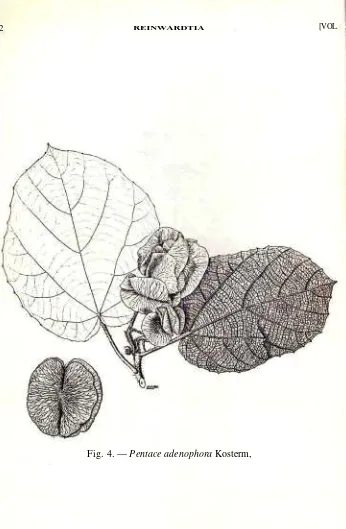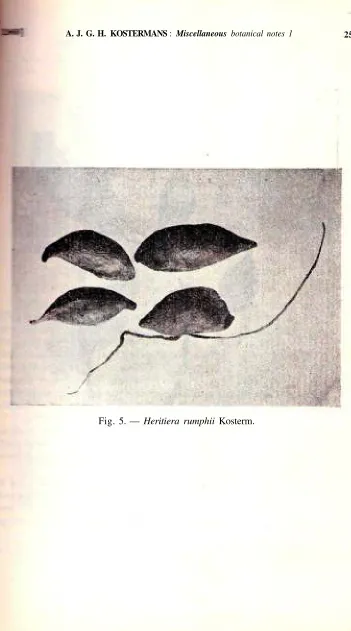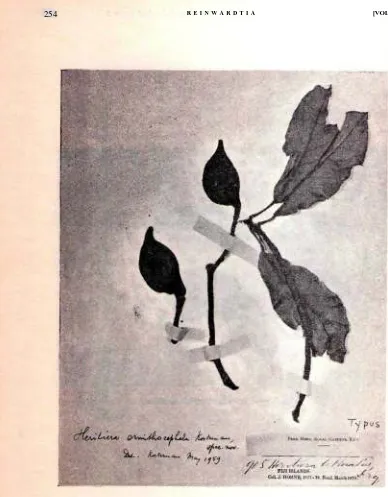REINWARDTIA
Published by Herbarium Bogoriense, Kebun Raya Indonesia Volume 5, Part 3, p.p. 233 - 254
MISCELLANEOUS BOTANICAL NOTES 1*
K.. J. G. H. KOSTERMANS**
SUMMARY
Papuodendron C. T. White is reduced to Hibiscus L.; the species is renamed:
H. papuodendron Kosterm.
Hibiscus hooglandianus represents a new species from New Guinea.
New species in Pentace: P. microlepidota Kosterm., P. paludosa Kosterm. and
P. adenophora Kosterm.
Parapentace Gagnepain is included in Burretiodendron Rehd. As the species of
Parapentace were published without latin diagnosis, the following new species of
Burretiodendron are presented: B. tonkinensis Kosterm. and B. brilletii Kosterm. Two new species of Heritiera (H. rumphii Kosterm. and H. ornithocephala Kos-term.) are described; additional notes on H. littoralis from Madagascar, H. longi-petiolata and H. arafurensis are presented.
Heritiera burmensis Kosterm. is reduced to a synonym of H. macrophylla Kurz.
Sterculia cubensis Urb. is referred to Hildcgardia; the curious distributional area of Hildegardia is stressed.
A note on Hildegardia erythrosipkon Kosterm. is presented.
Sterculia ankaranensis Arenes is relegated to Hildcgardia.
Sterculia heritieriformis Arenes represents a mixture of Heritiera littoralis and
Firmiana colorata.
Sterculia guppyi Greenwood is a synonym of Firmiana diversifolia A. Gray.
Ficus serp-yllifolia Blume belongs actually to Apocynaceae and is renamed: Micrc-chites serpyllifolia (Bl.) Kosterm. It is suggested that M. radicans Markgr. is conspecific with this wide-spread species.
Ortholobium Gagnepain, being inadmissable under the Rules (no latin diagnosis) is replaced by Cylindrokelupha Kosterm. The following new species are presented:
C. poilanei Kosterm., C. platyphylla Kosterm.; C. annamcnse Kosterm. and C. che-valieri Kosterm.
A c k n o w l e d g m e n t s .
I wish to express here my gratitude to the Ford Foundation, New York
and the UNESCO (Southeast Asia Branch), who enabled me by generous
grants to visit numerous Herbaria and Botanical Institutes all over the world.
The
results of this tour, which took place in 1959, will be published in a
series of papers, of which this is one.
This is the first of series of notes presenting the results of a botanical study tour around the world, sponsored by the Ford Foundation, New York.
D. Sc; Advisor Forest Research Institute, Bogor; Collaborator Herbarium Bogo-riense, Bogor.
2 3 4 R E I N W A R D T I A [VOL. 5
To Dr. C. G. G. J. van Steenis, I am, as always, indebted for his going through the MSS.; his critical remarks eliminated many mistakes and short-comings.
Mr. J. van Borssum-Waalkes, the authority in Hibiscus and Dr. van Steenis commented at length on Papuodendron. For this stimulating ex-change of ideas, I am very grateful, and although agreement was not reached, it helped to clarify the problem.
Mr. Anwari Dilmy, the Director of the Herbarium, gave his continuous support in matters directly and indirectly connected with my work. I take this opportunity to express my sincere gratitude.
To Messrs Soekirno, Moh. Anwar and Damhuri, I am indebted for the drawings and to the Harvard University Herbarium for the photograph of Heritiera ornithocephala.
MALVACEAE
PAPUODENDRON C. T. White
This monotypical genus was published in 1946 (in J. Arnold Arb. 27: 272) and was included in Malvaceae. Van Steenis (in J. Arnold Arb. 28: 422. 1947) referred the genus to Bombacaceae, although White, quoting Dadswell, had pointed out that the wood structure fitted the tribe Hibisceae rather than the tribe Durioneae, as it lacked "tile cells" in the medullary rays, characteristic for the latter.
Borssum Waalkes (in Reinwardtia 4: 41—68. 1956) described several Hibiscus species (H. pulvinulifer, H. womersleyanus, H. carrii), which are very close to Papuodendron lepidotum and could be easily referred to that genus.
The only difference between Papuodendron and Hibiscus is the position of the anthers. In Hibiscus the anthers are rather spaced on the filament tube (which means, that the original filaments differed conspicuously in length) and the staminal tube ends beyond the last anther usually in 5 teeth, which might represent as many sterile filaments.
In Papuodendron the anthers are closely packed, which means that their filaments are almost equal in length. In Papuodendron lepidotum the 5 sterile teeth are lacking or are too small to be detected.
1960] A. J. G. H. KOSTERMANS : Miscellaneous botanical notes 1 235
carrii, H. hooglandianus, H. papuodendron, H. pulvinifer and H. womers-leyanus should be constant and differing from that in Hibiscus the genus Papuodendron should be reinstated. For the time being I follow Borssum-Waalkes, who has revised Hibiscus.
The character of the stamens is again an argument, that Bombacaceae are hardly separable from Malvaceae, if at all.
In Durio, species occur with free filaments, i.e., the filaments are group-ed in 5 phalanges, of which the composing filaments slightly adhere at base. In other species a tube is formed, in which the composing filaments are free at different heights, a situation comparable to that in Hibiscus; likewise there are sterile filaments interpaced with the fertile ones. Sometimes there are single stamens in between the 5 phalanges. This all suggest, that the original number of stamens was 5 (or multiple of that) and as suggested by others, the phalanges could well represent stamens, which have multiplied by division. In some Durio species, each filament bears a single cell, but, if indeed these filaments are the result of splitting, this single cell could well represent only half an anther.
The same phenomenon occurs in Heritiera, Pterocymbium and Sca-phium in Sterculiaceae. Here again is a staminal tube, where the anthers are placed in a group at the top, but like in Papuodendron (and Hibiscus), they are either spaced, because of the difference in length of their filaments, and then form a irregular clump, or the filaments are equal in length and their anthers are than placed in a regular ring. Especially in the first case, it is often clear, that the apical part of the anther has split and the cells have become separated, which gives the impression of the anthers having one cell only. The number of cells, however, is 10, which fits with the suppo-sition of 5 anthers, each with two cells.
Hibiscus papuodendron Kosterm., nom. nov. — Papuodendron lepido-tum C. T. White, I.e.). The specific epithet "lepidotum" is not available because of Hibiscus lepidotum Borssum-Waalkes, I.e. 63.
An undescribed Hibiscus species, which I included temporarily (MSS) in Papuodendron is treated below. It is named in honour of Dr. R. D. Hoog-land, a well-known collector and botanist of Australian New Guinea.
1. Hibiscus hooglandianus Kostermans, spec. nov. — Fig. 1.
236 R E I N W A R D T I A [VOL. 5
soft to cut. Branchlets, leaves and inflorescences covered with minute, scat-tered, pale, round scales. Leaves rigidly chartaceous, ovate-orbicular, 16—19 by 13—18 cm long, base truncate or subcordate, top acuminate; both sur-faces covered with scales; upper surface with obscure veins, prominent on lower one; the two lowest lateral nerves starting from the petiole inser-tion or slightly above it, lower down a pair of almost horizontal, faint, short, lateral nerves, higher up to 5 pairs of distant, rather patent, lateral nerves, connected by distant parallel secondary nerves. Petiole 4—7 cm long, thick, subtended by large, foliaceous, ovate-orbicular, ca 1—1.5 cm long, caducous, stellate-pilose bracts.
Inflorescence terminal, up to 25 cm long, lepidote, consisting of a main rachis and distant racemes; the latter in the axil of reduced leaves; racemes erect-patent, lower part bare, upper part with shortly pedicelled flowers; each pedicel with a large bract at base. Flower buds globose, lepidote.
TYPUS. — N.G.F. 4160 (BO)
The species is close to H. womersleyanus Borssum-Waalkes, from which it differs mainly by its inflorescence character.
Papua, Central Div., Vesorogo Creek Trail, Sogeri, July, fl. buds, Womersley N.G.F. U60 (A, BISH, BO, K).
TlLIACEAE
PENTACE Hassk.
1. Pentace microlepidota Kosterm., spec. nov. — Fig. 2.
Arbor, ramulis perparce minute stellato-lepidotis, foliis chartaceis, or-biculatis vel ovato-oror-biculatis, basi cordatis vel truncatis, margine crenulatis, supra glabris, nervis impressis, subtus parce stellato-lepidotis, nervis basa-libus paucis palmatis; petiolis longis, apice incrassatis, dense stellato-pilosis, sparse minute hirsutis, glabrescentibus; fructum alis semiorbicularibus, spar-se minute stellato-lepidotis.
1960] A. J. G. H. KOSTERMANS: Miscellaneous botanical notes 1 287
Infructescence up to 27 cm long with a long, stout, minutely stellate-lepidote main stalk and slender densely stellate-stellate-lepidote few ramifications, up to 6 cm long. Fruit covered with sparse, minute, stellate hairlike scales, glabrescent. Wing semiorbicular, up to 2 x 3 cm.
TYPUS: Kep. 30305 (KEP).
The specimen is characterized by the large sparsely scaly leaves and samaras.
MALAY PENINSULA, Perak, Tapak, Plus Forest Reserve, Sept., fr., Kep. 30306
(KEP, K), 30305 (KEP) and 45220 (KEP).
2. Pentace paludosa Kosterm., spec. nov. — Fig. 3.
Arbor (?), ramulis gracilibus adpresse lepidotis; foliis chartaceis, lanceolatis, acuminatis, supra glabris lucidis, nervo mediano impresso, subtus dense adpresse minute lepidotis, nervo mediano prominente, nervis lateralibus teneribus; petiole dist-incto; inflorescentibus axillaribus, lepidotis, laxe paniculatis; pedicellis distinctis; calycis tubo distincto, lobis ovato-acutis, lepidotis; petalis unguiculatis spathulatis glabris quam sepalis multo longioribus; staminibus numerosis, glabris, liberis; sta-minodis liguliformibus; ovario dense fimbriato-lepidoto, costato; stylo glabro longo; stigmate inconspicuo.
Tree (?) with slender, densely, minutely adpressed lepidote branches (scales without fringe, often irregular). Leaves chartaceous, lanceolate, 8—12 x 3—3.5 cm, base shortly acute, apex long acuminate with blunt tip, above smooth, glabrous, midrib impressed; lower surface with two layers of minute non- fimbriate adpressed scales, the top scales larger, midrib prominent, nerves very slender, about 12 pairs, arcuate near margin; the lowest pair often opposite. Petiole slender 5—7 mm long, lepidote. In-florescences axillary, up to 7 cm long, adpressed lepidote, with few and short ramifications. Pedicels ca 5 mm long, slender, lepidote; calyx tube distinct, cylindrical, saccate at base, 2 mm high, densely fimbriate-lepidote, lobes ovate- acute, 2—3 mm, rarely very short. Petals glabrous, spathulate, unguiculate, ca 7 mm long. Stamens numerous, free, ca 4 mm, glabrous, anthers peltate. Staminodes liguliformous, glabrous, about as long as sta-mens. Ovary densely fimbriate-lepidote, ribbed, style longer than stamens, glabrous, truncate, slender; stigma small.
TYPUS: Bejaud 789 (P).
238 REINWARDTIA [VOL. 5
From the shape of the ovary, it may be assumed, that the species belongs in Pentace, although Biownlowia should not be outruled, before the mature fruit are known.
CAMBODIA: Trasiet, inundated forest, fl., Bejaud 789 (BO, P).
3. Pentace adenophora Kosterm., spec. nov. — Fig. 4.
Arbor, ramulis laxe rufo-hirsutis itemque pilosis, vel stellato-pilosis; foliis rigide chartaceis, suborbicularibus vel ovato-orbicularibus apice rotundatis vel minute apiculatis interdum subemarginatis, basi cordatis, supra glabris, nervis principalibus impressis, subtus densissime minute argenteo-stellato-pilosis, pilis cum setis remotis intermixtis, nervis promi-nentibus, hirsutis, nervibus lateralibus paucis prope margines in glandulas exeuntibus; petiolis conspicuis, hirsutis, stellato-pilosis, glabrescentibus; infructescentibus terminalibus magnis, glabrescentibus; fructibus alatis, alis hirsutis magnis; inflorescentis dense rufo-stellato-pilosis, ramulis distantibus; bracteis lanceolato-acutis, hirsutis; floribus pedicellatis; sepalis pilosis, ovato-acutis, basi connatis; petalis subspathulatis glabris sepalis longioribus; stam-inibus in phalangis 5 coalitis; staminodis 5, linearibus glabris.
Tree 25—35 m, diam. 70 cm. Buttresses 1—3 m, thin, out 1—2 m. Bark darkbrown, fissured, scaly; living bark 10 m, pink to red-brown, inner layer yellow, fibrous. Sapwood yellowish, merging into the redbrown heartwood. Branchlets densely rusty stellate pilose, interspaced with stiff bristles or the bristles absent. Leaves rigid chartaceous, sub-orbicular or ovate-orbi-cular, 8—14 x 9—15 cm, apex rounded or emarginate and often apiculate, margin crenulate, glandbearing at the end of the lateral nerves, base cor-date; upper surface glabrous, main nerves impressed, lower surface covered with a dense, grey felt of small stellate hairs, interspaced with stiff bristles, the latter more numerous on the main nerves, veins prominent, lateral nerves 3—4 (—5) pairs (the lower pair at petiole insertion), base often 7-nerved; secondary nerves parallel, prominent, reticulation lax, prominu-lous. Petiole 4—8 cm, apical part often with stiff bristles, glabrescent. In-florescence terminal, leafy, up to 40 cm long with distant stiff branches, partial inflorescences hardly branched, about 10 cm long, densely lightbrown stellate-pilose; bracts narrowly ovate-acute, persistant for a long time.
1960] A. J. G. H. KOSTERMANS : Miscellaneous botanical notes 1 289
the staminal phalanges. Wing of fruit stellate-haired, nut with stiff bristles; wing vieux rose, semi-circular, up to 3 x 6 cm.
TYPUS: Kostermans 13614- (BO)
DISTRIBUTION: Malay Peninsula, Sumatra, Borneo.
The species is easily recognized by the marginal glands of the crenulate leaves and the pilose samaras. In young trees the leaves are toothed and have a long acumen. They are up to 25 x 30 cm with a 15 cm long petiole.
MALAY PENINSULA: State Land Dungun, Jarangan, 3 miles from Police Station, flatland. July, fl., Kep. 80810 (A, K, L, SING); Pahang, K. Rompin, alt. 30 m, fr. June, Kep. 75895 i(KEP); Trengganu, 34th mile Kuala Trengganu - Besut Road, lowland, young tree, Sinclair and Ktah bin Salleh S.F.N. 40771 (A, BO, K, L, SING); INDONESIA. S u m a t r a , Inderagiri, alt. 75 m, Sept. ster., 66.30074- (A, BO, L); B o r n e o . N. Borneo. Kabili For. Res., Sandakan, detached leaves only, Sy-mington 35645 (KEP); ibid., young tree, Sinclair 9317 (BO, K, SING); ibid., ster.,
B.N.B.F.D. 9294 (BO); ibid., Compt. 10, Kabili F. R., ster., Agama & Puasa 9294
(SING); ibid., June, fr., Puasa 4871 (SING); Temburong, Mile % Bangar-Batu Apas Road, March, fr., Saw 17096 (A, BO, BRI, K, KEP, SING); Indonesian Borneo. East Borneo, Sangkulirang distr., Karangan R. region, sandstone, Aug., fr., Kostermans 1314 (BO, L); ibid., young tree, Kostermans 13598 (A, BO, CANB, K, L, SING); West Kutei, Mujup, alt. 50 m, ster., 66.16736 (BO, L) ; East Kutei, Pengadan, ster., 66.12960
(BO, K, L).
BURRETIODENDRON Rehder and PARAPENTACE Gagnep.
Burretiodendron Rehder was published in 1936 (in J. Arnold Arb. 17: 47) and based on Pentace esquirolii Leveille, which Rehder considered to be not related to any other genera of Tiliaceae or Sterculiaceae by the uni-sexual flowers, the lack of the 5 staminodes inside the row of stamens, the oblong stamens, and the elongated wings of the fruit and especially by the nectary at the base of the sepals.
In 1943 (in Bull. Soc. bot. France 90: 70) Gagnepain created the genus Parapentace with two species. No latin diagnosis of the genus was given, which consequently is not considered to be validly published (Article 34 of the Paris Code).
As is evident from the descriptions (I had moreover the opportunity to examine all specimens) the two genera mentioned above are synonymous, which make the following renaming necessary.
I960] A. J. G. H. KOSTERMANS: Miscellaneous botanical notes 1 241
Tree 30 m. tall, 50 cm diameter. Buttresses small. Bark dark brown, cracked, peeling off in large pieces. Branchlets densely adpressed lepidote, scales very small, fimbriate. Stipules aciculate, 1 cm, caducous. Leaves char-taceous, elliptical 13—30 x 5—17 cm., top obscurely acuminate, base round-ed or obscurely subcordate; above glabrous, smooth, lateral nerves slightly impressed; lower surface densely adpressed, minutely, silvery lepidote, midrib prominent, nerves ca 10 pairs, prominent, running out arcuately towards margin, the lower two pairs opposite, slightly subtriplinerved; secondary nerves prominulous, lax. Petiole up to 3.5 cm long, swollen at both ends, lepidote. Fruit ellipsoid-ovoid, glossy, smooth, nut up to 7.5 cm long, 3.5 cm wide, a short neck at base, apex with a conspicuous triangular up to 2.5 cm long wing which merges gradually into the basal ridge of the nut.
TYPUS. — Kuswata & Soepadmo 303 (BO).
The species was mentioned for the first time by Rumphius in 1743, but never collected again. The description of the leaves, as given by Rum-phius fits, but he described the fruit as being shorter, broader and rounder than those of H. littoralis, which they are certainly not. I formerly included the species hesitatingly in H. arafurensis. When the two botanists Kuswata and Soepadmo planned to make a collecting trip to the island of Amboina, I asked them to be on the look-out for this species. They were very lucky to locate a tree not far from the township of Amboina and found plenty of old fruit together with seedlings, the later were brought alive to the Bogor Gardens.
The fruit resembles somewhat that of H. littoralis, but the wing is differ-ently shaped. The leaves resemble those of H. novoguineensis by their long petioles.
AMBOINA, road from Ambon township to Kusukususereh, about 2 km from Ambon, Manggadua, limestone rocks, alt. 150 m., Kuswata and Soepadmo 303, old fruit Sept. (A, BO, K, L, LAE, P, SING, US).
2. Heritiera ornithocephala Kosterm., spec. nov. — Fig. 6.
Brownlowia species, A. C. Smith in J. Arnold Arb. 26: 101. 1945.
Arbor, ramulis dense lepidotis; foliis alternantibus rigide chartaceis vel coriaceis ellipticis acutis vel subacutis, basi subobtusis, subtus lepidotis, distincte petiolatis; fructibus caputis avis simillimmus, lepidotis.
242 REINWABDTIA [VOL. 5
slightly narrowed and obtusish; upper surface smooth, somewhat glossy, veins flush with the surface or very slightly raised; lower surface with a dense adpressed layer of tiny, radially striate, aureous, fimbriate scales; midrib prominent, nerves 12—13 pairs, the lowest pair starting at the petiole insertion; secondary nerves scarcely prominulous, laxly reticulate. Petiole 1.6—2 cm long. Fruit shaped like a birds head, sessile, with a short neck at base, densely, minutely lightbrown-lepidote, the fruit 4.5—5 cm long, 2.5 cm diam., 1.7 cm thick, more or less obliquely ellipsoid-globose; the beak (wing) flattened and obtuse, about 1 cm long.
Infructescence 4.5 cm long (not including fruit).
TYPUS. — Home 905 (A).
Vernac. names. Tofaki; Rongi (Tholo North); Thaundamu (savai). Apart from the rather poor type specimen, collected between 1877—78 in Fiji, no fertile specimens are known. Several specimens, collected from young trees, are known. They were not recognized and incorporated in Brownlowia, Tiliaceae) and one in Heritiera littoralis.
The leaves of the youngest specimens are up to 30 x 14 cm, the lower leafside being silvery; in older trees the leaves become gradually smaller and the lower leaf surface becomes more aureous. The stipules are up to 1.5 cm long, slender and acute.
FIJI ISL., Mandarivatu, alt. 1000 m, March, ster., Mead F.N. 1975 (K); Viti Levu, Rewa Prov., slopes of Korombambu Mt., alt. 200 m, Aug., ster., Gillespie 2372
(GH); Namosi Prov., near Namuamua, alt. 400 m, Sept., ster., Gillespie 8000 (GH); ibid., ster., Greenwood 957 A (A, BISH, GH, K, US); Tholo North, Mt. Victoria, alt. 970 m, May, ster., Greenwood 1177 (BISH, GH) ; Mba, Lantoka, East of sawmill at Navai Hills between Nggaliwana and Tumbeiin dreketi Creeks, alt. 800 m, young tree, A. C. Smith 6019 (A, GH, K, US); S. slopes of Nansori Highlands, in drainage of Nemosi Creek above Tubenasole, alt. 400 m., ster., A. C. Smith 4580 (A, GH, K, US); locality not indicated, fr., Home 905 (A, K) ; Tonga Isl. Kao, May, ster., Yuncker 15949 (US) ; Niue, alt. 500 m ster., Greenwood 957 (A, BISH, GH, K, US); Mutukau, alt. 65 m, Yuncker 10244 (BISH, K).
3. HERITIERA LITTORALIS Ait.
1960] A. J. G. H. KoSTERMANS: Miscellaneous botanical notes 1 243
As to the subspecies Ralima I omited to examine (in Paris) the spe-cimens closely; the shape of the fruit falls within the variability of H. litto-ralis: the branch depicted as subspecies littoralis (IV, 2) is aberrant by its long petioles. Plate IV, 1 depicts a typical H. littoralis branch. Has a mix-up of branches and detached fruit occurred?
In that case — if IV. 2 and IV, 7 belong together, an undescribed species is involved.
4. HERITIERA LONGIPETIOLATA Kanehira.
In my paper: "A monograph of the genus Heritiera" (Publication 1, Council for Sciences of Indonesia, Djakarta, April 1959), the citation of the numbers Fosberg 26383 and 25404- should be deleted. They represent H. littoralis.
5. HERITIERA ARAPURENSIS Kosterm.
That this species occurs in N. Celebes can be proved now by a specimen, collected by Riedel (s.n., fruiting, K) in Gorontalo; the numbers bb. 32484
and 31884 can now be definitely relegated to this species.
6. HERITIERA BURMENSIS Kosterm. and H. MACROPHYLLA Kurz.
After having been in the position to examine more material of H. macro-phylla in the Dehra Dun, Calcutta and Kew herbaria, 1 have come to the conclusion, that H. burmensis is conspecific with H. macrophylla and has to be deleted.
In the Stockholm herbarium I found a specimen of H. macrophylla, marked Heritiera grandis Fisch., leg. K. Forsberg, floret Kew 1850; H. ma-crophylla Hortor. belg.). This might represent the base for H. grandis Fisch. ex Steudel (nomen). It is possible that H. fischeri Regel and Rach. represents also H. macrophylla.
In the Baillon herbarium in Paris a specimen of H. littoralis is repre-sented, which is marked Systemon fischeri Regel. This might be the base of H. fischeri (S. fischeri = Galipea Aubl., Rutaceae).
HILDEGARDIA Schott & Endl.
1. Hildegardia cubensis (Urban) Kostermans, comb. nov.
Sterculia cubensis Urban (basionym), Symbol. Antill. 9: 235. 1924.
244 KEINWARDTIA [VOL. 5
is endemic in Cuba. The tree with its grey-green, glossy, smooth bark, but-tresses, the small crown, the succulent leaves, the branchlets with the large soft pith, reminded me immediately of Hildegardia.
Dr. Royg y Mesa could provide me with some fruiting material of this tree, collected several years before and it became at once clear, that Ster-culia cubensis belongs in Hildegardia. The fruit are flat, papery, non-dehis-cent and have one seed.
In Leon and Alain, Flora de Cuba 3: 290. 1953, nothing is said about the fruit, which was apparently unknown to these authors. They state that the species is in danger of becoming extinct.
The tree occurs in a limited area between the provinces of Oriente and Camaguey.
In Stockholm I had the opportunity to examine the type specimen of St. cubensis Urban (Ekman 4867); although the fruit of H. cubensis strongly resemble those of H. barteri (Mast.) Kosterm. from Africa, a tree cultivated all over the tropics in Botanic Gardens, the flowers are entirely different. The genus Hildegardia has a very peculiar distribution; one species in Cuba, two in tropical east Africa, three in Madagascar, one in continental tropical Asia, one in the Philippines and one on the island of Sumbawa in Indonesia.
2. In my paper: A monograph of the genus Heritiera (Publication of the Council for Sciences in Indonesia, April 1959, Djakarta) page 74 two mistakes crept in. The combination Hildegardia erythrosiphon (Baillon) Kostermans was published already in 1954 (in Bull. Jard. bot. Bruxelles 24: 335), whereas the combination H. perrieri (Hochreutiner) Arenes was made by Arenes in 1956 (in Mem. Inst. scientif. Madagascar, ser. B. vol. 7: 122).
3. The type specimen of Hildegardia merrittii (Merr.) Kosterm. (Mer-ritt F.B. 8555) could be examined in the New York Botanical Gardens her-barium (an isotype specimen is deposited in the Kew Gardens Herher-barium). The specimens consists of some old, fallen, deteriorated leaves and loose fruit.
4. HILDEGARDIA ERYTHROSIPHON (Baill.) Kosterm.
Arenes (in Mem. Inst. scientif. Madagascar, ser. B. vol. 1: 2—5. 1949; ibid. 7: 122—123. 1956) recognizes no less than 3 subspecies, 7 varieties and even 2 subvarieties of this species.
A. J. G. H. KOSTERMANS : Miscellaneous botanical notes 1 245
one is well acquainted with the variabily in the field. The variation in ingle individual tree is already very large. Although I have not examined above mentioned varieties, etc., I am sure that a revision will prove they do not exist or that different species are involved; the chance for latter is, however, very small.
5. Hilde gardia ankaranensis (Arenes) Kosterm., comb. nov.
Sterculia ankaranensis J. Arenes (basionym) in Mem. Inst. scientif. Ma-dagascar, ser. B, 7: 72. 1956.
I could examine the type specimen (Humbert 18981 bis) in the Paris herbarium. The leaves are typical for Hildegardia and according to the structure of the follicle (which has been torn open in the type specimen) it must definitely be a Hildegardia.
STERCULIA L.
1. STERCULIA HERITIERIFORMES J. Arenes.
Of this species, published in Mem. Inst. scientif. Madagascar, ser. B., vol 7: 71. 1956, fig. Ill, I could examine the type specimen in the Paris herbarium.
I agree with Capuron, who made a note on this specimen, that it repre-sents a "mixtum compositum", the leafy branch belongs to Heritiera litto-ralis, the flowers are those of Firmiana colorata.
The scales of the lower leaf surface of Heritiera littoralis are wrongly drawn.
2. STERCULIA GUPPYI Greenwood
This name was published in Kew Bull. 1929: 240 to replace Sterculia diversifolia (A. Gray) Seemann (Fl. Vit. 23. 1865), as the latter is a later homonym of Sterculia diversifolia G. Don, 1830 from Australia, As, however, the status of Firmiana has been well established now, Sterculia guppyi be-comes a synonym of Firmiana diversifolia A. Gray, whereas Sterculia diver-sifolia G. Don represents Brachychiton diversifolium (G. Don) R. Br.
APOCYNACEAE.
FICUS SERPILLIPOLIA Blume.
2 4 6 R E I N W A R D T I A [VOL. 5
medicinal herb), of which a fragment is represented in the Bogor Herbarium. The species has been collected many times since, but all specimens are sterile. Because of its opposite leaves, I referred it to Apocynacae. After E. H. J. Corner (Cambridge) expelled it from the genus Ficus and referred it tentatively to Willughbeia in Apocynacae, I re- examined the Bogor spe-cimens and I am now able to refer the species definitely to Micrechites as Micrechites serpyllifolia (Bl.) Kosterm. comb. nov. (basionym: Ficus serpyl-lijolia Bl.). A flowering specimen of Micrechites radicans (Wall.) Markgraf from New Guinea (Brass 8091) is almost certainly conspecific with our species. The species is widely distributed in Malaysia. I collected it in Borneo. Blume himself altered the orthography of the specific epithet on the label of his type specimen; I believe it advisable to follow this correction.
LEGUMINOSAE
ORTHOLOBIUM Gagnepain and CYLINDROKELUPHA Kosterm.
As Ortholobium Gagnepain was published in 1952 (in Bull. Soc. bot. France 99: 36) without a Latin description, and since it does not represent a "descriptio generico-specifica", the name was not validly published and has to be replaced by Cylindrokelupha Kosterm. (in Bull. 20, Organis. scient. Research Indonesia 20, Dec. 1954; Addit. Notes on Mimosaceae; the genera Mammea L. and Ochrocarpos Thou. 7, Jan. 1956).
It is recommended in the Rules to avoid the use of nomina nuda which Gagnepain's names are not. In the interest of stability of nomenclature it is better to take up his names.
1. Cylindrokelupha poilanei Kosterm., spec. nov.
Ortholobium umbellatum Gagnep. (nomen inval.) in Bull. Soc. bot. France 99: 37. 1952.
Hi] A. J. G. H. KOSTERMANS: Miscellaneous botanical notes 1 247
sinuatis; antheris orbicularibus, bast apiceque emarginatis, deinde promin-entibus. Ovarium 2 mm. stipitatum, 2.5—3 mm. longum, glabrum; ovulis usque 10 et ultra. Legumen saepissime solitarium subsessile, 10—12 cm. longum, rectum, cylindraceum, 2.5—3 cm. latum crassumque; seminibus globosis, vel compressim truncatis, 25 mm. diam., saepe medulla dissepi-mentiiformi disjunctis.
TYPUS. — Poilane 6328 (P).
VERNAC. NAMES. — Cay dai heo; Bopla unh.
ANNAM. — N. of Ninh-hoa, Prov. of Nhatrang, Poilane 6328 (P).
-2. Cylindrokelupha platyphylla Kosterm. spec. nov.
Ortholobium platyphyllum Gagnepain. (nomen inval.) in Bull. Soc. bot. France 99: 37. 1952.
Arbor 8—9 m. alta; trunco 15 cm. diam., mox ramoso, ramis numerosis. Ramuli glaberrimi, pallide rufi, teretes, 5 mm. crassi, sat virgati vel sinuati. Folia pinnata, petiolo communi 4 cm. longo, petiolos secondarios inaequales ad apicem gerente; foliolis in unumquinque 6, ovalibus; supremis 15 cm. longis, 10 cm latis atingentibus, minoribus 10 cm. longis, 7 cm latis, omnibus supra nitidissimis, infra pallidioribus, basi obtusis, apice attenuato-obtusis, symetricis; nervis secundariis 3—4-jugis, ad costam decurrentibus; venulis laxe leticulatis; petiolulo 5 mm. circiter longo. Inflorescentiae fructigerae raceviosae, capitula efformantiae, breves, 15—20 cm. longae, oligocarpae. Pedunculus ultimus 1—2 cm. longus, legumen immaturum gerens, 6 cm. longum, 3 cm latum, marginibus rectis, compressum, faciebus concavius-culis. Legumen maturum (jide Poilane) longum crassumque, seminibus
crassis.
TYPUS. — Poilane 11161 (P). VEENAC. NAMES. — To no chi an.
The mature pods should weigh 1 kilogram and the seeds 0.1 kg. accord-ing to Poilane.
ANNAM. S. E. of Lang-khoai, Prov. of Quang-tri, Poilane 11161 (P) ; Prov. of Thanh-hoa, Phong-y, Poilane 1650 (P); Prov. of Vinh, Bukhang, Poilane 1666U (P).
3. Cylindrokelupha annamense Kosterm., spec. nov.
Ortholobium annamense Gagnepain (nomen invalid.) in Bull. Soc. bot. France 99: 37. 1952.
2 4 8 R E I N W A R D T I A [VOL. 5
petiolis secundariis oppositis 1-geminis, 4—5 cm. longis, 2—6 foliolis geren-tibus; foliola lanceolato-oblonga, basi attenuata, apice acuminata, suprema ampliora, 7—10 cm. longa, 2—3.5 cm. lata, glaberrima, subsymetrica; nervi secundarii 6—7 utrinque, ad costam decurrentes, intra marginem arcuati confluentesque; petioluli 3—4 mm. longi; glandula cupularis, ad apicem petiolum sita. Inflorescentia 10 cm. longa paniculata, capitula gerans, flor-ibus pilosis, pilis appressis; inflor. fructigera axillaris capitula nonnulla saepe legumen solitarium gerens, pedunculo communi 4—6 cm. longo, capi-tulo circiter 10-floro (id est cicatricibus 10 notato). Calyx glaber sessile; corolla appresse pilosa (teste reliquiae). Legumen (haud maturum) 10cm. longum, 15—20 mm. latum, crassum sed faciebus planis, rectum; maturum 3.5 cm. latum, 2.5 cm. crassum; semina globosa vel ellipsoidea 15—20 mm. diam.
TYPUS. — Poilane 24418 (P). VERNAC. NAME. — Xi ko clio (Moi).
ANNAM. Prov. Haute Donnai, Braian near Djiring, Poilane 24418 (P) ; Prov. Darlac, Chu-yang-sin Mountain range, Poilane 32620 (P) ; E. of Nhatrang, Poilane 4385 (P) ; Tonkin, prov. of Vinh-yen, Tam-das, Eberhardt 5029 (P).
4. Cylindrokelupha chevalieri Kosterm., spec. nov.
Ortholobium chevalieri Gagnepain (nomen invalid.) in Bull. Soc. bot. France 99: 38. 1952.
Ramuli grisei, 3 mm. crassi, deinde pulverulenti vel furfuracei. Folia bipinnata; petiolus communis 15 mm. longis; petioli secundarii 2.3 cm. longi, bifoliolati, graciles, glabri, foliolis alternis, symetricis, lanceolatis, basi acuto attenuatis, apice acuminato-obtusis, persistentibus, firmis vel subcoriaceis, supra nitidis, in sicco brunnescentibus, 7—9 cm. longis, 3—4 cm. latis; nervis secundariis 3—4 jugis, suboppositis, ad costam decurrentibus, infimis apicem subattingentibus, intra marginem arcuatis confluentibus; venulis transversalibus reticulatisque infra prominulentibus. Inflorescentia fructi-gera 10 cm. longa, capitula nonulla gerens; flores ignoti. Legumen monosper-mum orbiculare, valde convexum, 3 cm. diam; vel 3-spermonosper-mum, oblonga, 10 cm. longum, circiter 4 cm. latum, 2 cm. crassum, rectum, valde convexum, basi 1 cm. stipitatum, apice abrupte apiculatum, faciebus levibus, venis laxe reticulatis; semina 1—3, subglobosa, vel compressim truncata, 2.5—3 cm. longa, 2—2.5 cm lata false dissepimentis disjuncta.
TYPUS. — Chevalier 38636 (P).
ANNAM. Prov. of Nhatrang, Hon-ba mountain range, Chevalier 38636 (P); ct
A. J. G. H. KOSTERMANS : Miscellaneous botanical notes 1 249
250 R E I N W A R D T I A [VOL.5
A. J. G. H. KOSTERMANS: Miscellaneous botanical notes 1 251
252 REINWARDTIA [VOL. 5
A. J. G. H. KOSTERMANS : Miscellaneous botanical notes 1 253
254 R E I N W A R D T I A [VOL.
